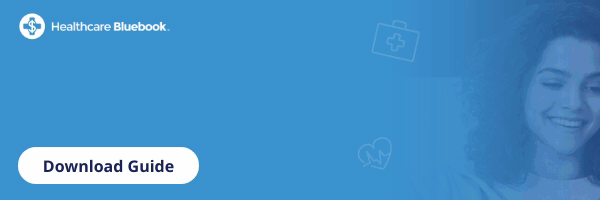
Healthcare is becoming more complex, and costs are increasing for patients and employers, prompting employers to look at healthcare transparency and navigation tools as a solution.
However, before implementing such a tool, employers need to understand the differences between transparency tools provided by carriers and independent healthcare navigation tools like Healthcare Bluebook. Let’s explore how independent navigation tools differ, why it matters, and four ways the best solutions can benefit organizations and their workers.
How Independent Healthcare Navigation Tools Differ and Why It Matters
Healthcare navigation tools help health plan members make informed decisions about their care. Although both carrier tools and independent tools are typically provided at no cost to the enrolled member, the navigation tools differ in some key areas, starting with the data that drives them.
The data behind free carrier tools is different from select independent healthcare navigation solutions. For example, carrier tools may be powered by information based on negotiated rates between the plan and the provider rather than actual medical claims. Additionally, most are cost-only tools that do not include objective quality data.
The most comprehensive navigation solutions identify in-network providers, out-of-pocket cost estimates, quality rankings for inpatient and outpatient facilities, and doctors by procedure. Independent tools may also offer additional benefits, such as access to a care navigator or member concierge to guide members through the process of scheduling care and finding high-quality physicians.
Top Benefits of Independent Healthcare Navigation
Some of the top benefits of comprehensive independent healthcare navigation tools include:
Informed Decision Making
Independent healthcare navigation tools enable employees to find in-network providers who perform common shoppable procedures. These tools also display out-of-pocket cost estimates and quality rankings for doctors and facilities that perform a given procedure.
The result? Employees feel empowered to make informed decisions about their care and have information about cost and quality before they schedule their appointments, leading to a healthier workforce and substantial cost savings.
Reduced Costs
The cost of the same procedure at different hospitals or even within the same hospital with different providers or insurance coverage can vary up to 1,000 percent. On top of this, many patients may not realize they can shop around for healthcare services to find high-value options.
However, with healthcare navigation solutions, patients can compare the cost and quality ratings of doctors and facilities that perform the same procedure. And when more members use navigation tools to find in-network providers, employers and employees experience greater savings.
For example, Healthcare Bluebook’s independent healthcare navigation tools help employers save an average of $1,500 every time a member uses Bluebook. The color-coded green-yellow-red solution makes it easy to find providers who administer care at a Fair Price™. Green providers charge equal to or below a Fair Price, yellow providers charge slightly higher than Fair Price, and red providers charge significantly higher than Fair Price.
Improved Healthcare Experience
Healthcare is complex and can be confusing for many people. There are also differences in healthcare literacy between people, making it even more confusing and complex for some. Healthcare navigation solutions help level these differences with provisions like access to a member concierge who can explain the options and guide the member toward quality care.
For example, Bluebook CareConnect™ provides a member concierge who helps members schedule appointments, work through problems, and transfer medical records—all activities that patients may put off because the process is too stressful. The member concierge ensures members seek out the care they require and supports them throughout their entire care journey.
Improvement of Health Outcomes for Underserved Populations
Not all populations have equal access to high-quality healthcare. Even with legislation to expand insurance coverage to underinsured and uninsured groups, the most vulnerable populations still have trouble navigating the healthcare system.
Independent healthcare navigation tools can improve outcomes for underserved populations through services like care navigators assigned to members throughout their care journey, which can foster trust and empower the communities they serve.
The care navigator facilitates improved access to healthcare and supports members throughout the process, including addressing issues related to distrust in providers that may cause them to avoid treatment or ignore the health problem altogether.
Invest in the Right Healthcare Navigation Solution for Your Organization
Healthcare navigation solutions are essential, but choosing one that’s a good fit for your organization can be difficult. Find out what you should look for in your navigation tools with our resource, How to Choose a Healthcare Navigation Solution That's Right for Your Organization: Four Questions to Ask.

